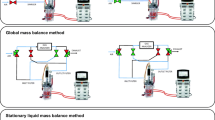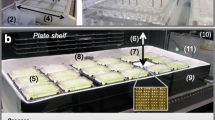Abstract
The effects of dissolved oxygen and the concentration of essential amino acids upon the metabolism of two mammalian cell lines (rCHO producing human active (t-PA) and a mouse-mouse hybridoma) were investigated in batch, chemostat, and perfusion cultures. Intracellular amino acid concentrations were measured for both cell lines during repeated batch cultures and the KS-values for the essential amino acids were calculated using Monod equations via computer simulation. The KS-values were in the range of 10 mmol L−1 and the pool of most intracellular amino acids remained constant at about 10–100 fold higher in concentration than in the medium. No significant differences were observed between the hybridoma and CHO cell. The specific nutrient uptake rates corresponded with the cell specific growth rate and the effects of reduced dissolved oxygen concentrations only became evident when the DO dropped below 5% of air saturation (critical concentration below 1%). Nevertheless, a correlation between nutrient concentration and specific oxygen uptake was detected.
Similar content being viewed by others
References
Al-Rubeai J, Mills D and Emery AN (1990) Electron microscopy of hybridoma cells with regard to monoclonal antibody production. Cytotechnology 4: 13-28.
Bender DA (1985) Amino acid metabolism. 2nd ed. John Wiley & Sons Ltd., New York, pp. 63-74.
Büntemeyer H, Lütkemeyer D and Lehmann J (1991) Optimization of serum free fermentation processes for antibody production. Cytotechnology 5: 57-67.
Büntemeyer H, Lütkemeyer D and Lehmann J (1991) Optimization of serum free fermentation processes for antibody production. Cytotechnology 5: 57-67.
Büntemeyer H, Stenner A, Seewöster T, Heidemann R, Tebbe H, Wallerius C and Lehmann J (1995) Comparison of nutrient requirements of mammalian cell lines. In: Beuvery EC, Griffiths JB and Zeijlemaker WP (eds.), Animal cell technology: Developments towards the 21st century. Kluwer Academic Publishers, Dordrecht pp. 117-121
Dalili M, Sayles GD and Ollis DF (1990) Glutamine-limited batch hybridoma growth and antibody production: Experiment and model. Biotechnol Bioeng 36, 74-82
Frame KK and Hu WS (1991a) Kinetic study of hybridoma cell growth in continuous culture. I. Amodel for non-producing cells. Biotechnol Bioeng 37: 55-64.
Frame KK and Hu WS (1991b) Kinetic study of hybridoma cell growth in continuous culture. II. Behaviour and comparison to nonproducers. Biotechnol Bioeng 38: 1020-1028.
Franec F, Vomastek T and Dolnikova J (1992) Fragment DNA and apoptotic bodies document the programmed way of cell death in hybridoma cultures. Cytotechnology 9: 117-123.
Gaertner JG and Dhurjati P (1993) Fractional study of hybridoma behaviour. 1. Kinetics of growth and antibody production. Biotechnol Prog 9(3): 298-308.
Glacken MW, Adema E and Sinskey AJ (1988) Mathematical descriptions of hybridoma culture kinetics: I. Initial metabolic rates. Biotechnol Bioeng 32: 491-506.
Guidotti GG and Gazzola GC (1992) Amino acid transporters: Systematic approach and principles of control. In: Kilberg MS and Häussinger D (eds.), Mammalian amino acid transport: mechanisms and control. Plenum Press, New York, pp. 3-29.
Halliwell B and Gutterridge JM (1985) Free radicals in biology and medicine. Clarendon, Oxford, University press.
Hansen HA and Emborg C (1994) Extra-and intracellular amino acid concentrations in continuous Chinese hamster ovary cell culture. Appl Microbiol Biotechnol 41: 560-564.
Heidemann R, Riese U, Lütkemeyer, D, Büntemeyer H and Lehmann J (1994) The Super-Spinner: A low cost animal cell culture bioreactor for the CO2 incubator. Cytotechnology 14: 1-9.
Heidemann R, Lütkemeyer D, Büntemeyer H and Lehmann J (1995) Determination of KS-values (Monod constants) for essential amino acids using CHO and hybridoma cells in batch and chemostat cultures. In: Beuvery EC, Griffiths JB and Zeijlemaker WP (eds.), Animal cell technology: Developments towards the 21st century. Kluwer Academic Publishers, Dordrecht pp. 735-739.
Heidemann R (1995) PhD-Thesis University of Bielefeld.
Hu WS, Dodge TC, Frame KK and Himes VB (1987) Effect of glucose on the cultivation of mammalian cells. Develop Biol Standard 66: 279-290.
Hewlett G (1991) Strategies for optimising serum-free media. Cytotechnology 5: 3-14.
Jäger V, Lehmann J and Friedel P (1988) Serum-free growth for the cultivation of a wide spectrum of mammalian cells in stirred bioreactors. Cytotechnology 1: 319-329.
Kilberg MS, Handlogten ME and Christensen HN (1981) Characteristics of system ASC for the transport of neutral amino acids in the isolated rat hepatocyte. J Biol Chem 256: 3304-3312.
Krömer E and Katinger HWD (1982) Effects of glucose-feeding on glucose-and oxygen requirement, energy charge and interferon production of human lymphoid cells cultivated in vitro. Develop Biol Standard 50: 349-354.
Kyung Y-S, Peshwa MV, Gryte DM and Hu W-S (1994) High density culture of mammalian cells with dynamic perfusion based on on-line oxygen uptake rate measurements. Cytotechnology 14: 183-190.
Leno M, Merten OW, Moeurs D and Hache J (1992) A kinetic study of hybridoma semicontinuous culture: Effects of dilution rate. In: Spier RE, Griffiths JB and MacDonald C (eds.) Animal cell technology: Developments, processes, and products. (pp. 221-223) Butterworth & Heinemann, Ltd.
Lehmann J, Vorlop J and Büntemeyer H (1988) Bubble-free reactors and their development for continuous culture with cell recycle. Animal Cell Biotechnology 3: 222-237.
Lin A and Miller WM (1992) CHO cell responses to low oxygen: Regulation of oxygen consumption and sensitization to oxidative stress. Biotechnol Bioeng 40: 505-516.
Lin A, Kimura R and Miller WM (1993) Production of tPA in recombinant CHO cells under oxygen-limited conditions. Biotechnol Bioeng 42: 339-350.
Meister A (1984) Enzymology of glutamine. In: Häussinger D and Sies H (eds.), Glutamine metabolism in mammalian tissues. Springer Verlag, Berlin Heidelberg, pp. 3-15.
Mercille S and Massie B (1994) Induction of apoptosis in oxygen-deprived cultures of hybridoma cells. Cytotechnology 15: 117-128.
Miller WM, Wilke CR and Blanch HW (1987) Effects of dissolved oxygen concentration on the hybridoma growth and metabolism in continuous culture. J Cell Physiol 132: 524-530.
Miller WM, Blanch HW and Wilke CR (1988) A kinetic analysis of hybridoma growth and metabolism in batch and continuous suspension culture: Effect of nutrient concentration, dilution rate, and pH. Biotechnol Bioeng 32: 947-965.
Miller WM, Wilke CR and Blanch HW (1989a) Transient responses of hybridoma cells to nutrient additions in continuous culture: I. Glucose pulse and step changes. Biotechnol Bioeng 33: 477-486.
Miller WM, Wilke CR and Blanch HW (1989b) The transient responses of hybridoma cells to nutrient additions in continuous culture: II. Glutamine pulse and step changes. Biotechnol Bioeng 33: 487-499.
Monod J (1942) Recherches sur la Croissance des Cultures Bacteriennes. Hermann, Paris.
Ozturk SS and Palsson BO (1990) Effect of dissolved oxygen on hybridoma growth, metabolism and antibody production in continuous culture. Biotechnol Prog 6: 437-446.
Oxender DL, Lee M, Moore PA and Cecchini G (1977) Neutral amino acid transport systems of tissue culture. J Biol Chem 252: 2675-2679.
Pirt SJ (1985) Principles of microbe and cell cultivation. Blackwell Scientific Publications, Boston, London.
Radlett PJ, Telling RC, Whitside JP and Maskell MA (1972) The supply of oxygen to submerged cultures of BHK 21 cells. Biotechnol Bioeng 14: 437-445.
Ryll T and Wagner R (1992) Intracellular ribonucleotide pools as a tool for monitoring the physiological state of in vitro cultivated mammalian cells during production processes. Biotechnol Bioeng 40: 934-946.
Reuveny S, Velez D, Riske F, Mcmillan JD and Miller L (1985) Production of monoclonal antibodies in culture. Develop Biol Standard 60: 185.
Schmid G and Blanch HW (1992) Extra-and intracellular metabolite concentrations for murine hybridoma cells. Appl Microbiol Biotechnol 36: 621-625.
Schmid G and Keller T (1992) Monitoring hybridoma metabolism in continuous suspension culture at the intracellular level. I. Steady-state responses to different glutamine feed concentrations. Cytotechnology 9: 217-229.
Seewöster T, Korioth F, Frey J and Lehmann J (1995) Transcription level of CHO cells influenced by amino acids. In: Beuvery EC, Griffiths JB and Zeijlemaker WP (eds.), Animal cell technology: Developments towards the 21st century. Kluwer Academic Publishers, Dordrecht pp. 735-739.
Shortwell MA, Jayme DW, Kilberg MS and Oxender DL (1981) Neutral amino acid transport systems in Chinese hamster ovary cells. J Biol Chem 256: 5422-5427.
Siano SA and Mutharasan R (1991) NADH fluorescence and oxygen uptake responses of hybridoma cultures to substrate pulse and step changes. Biotechnol Bioeng 37: 141-159.
Shi Y, Ryu DDY and Park SH (1993) Monoclonal antibody productivity and the metabolic pattern of perfusion cultures under varying oxygen tensions. Biotechnol Bioeng 42: 430-439.
Thömmes J, Gatgens J, Biselli M, Runstadler PW and Wandrey C (1993) The influence of dissolved oxygen tension on the metabolic activity of an immobilized hybridoma population. Cytotechnology 13: 29-39.
Wohlpart D, Kirwan D and Gainer J (1990) Effects of cell density and glucose and glutamine levels on the respiration rates of hybridoma cells. Biotechnol Bioeng 36: 630-635.
Rights and permissions
About this article
Cite this article
Heidemann, R., Lütkemeyer, D., Büntemeyer, H. et al. Effects of dissolved oxygen levels and the role of extra- and intracellular amino acid concentrations upon the metabolism of mammalian cell lines during batch and continuous cultures. Cytotechnology 26, 185–197 (1998). https://doi.org/10.1023/A:1007917409455
Issue Date:
DOI: https://doi.org/10.1023/A:1007917409455




